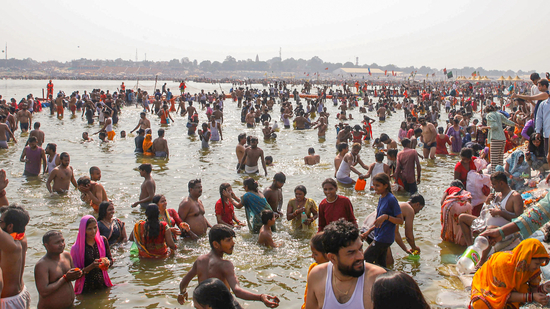Pollution in Sangam Water During Kumbh Mela: The Kumbh Mela in Prayagraj continues to witness an overwhelming number of devotees. So far, 593.1 million people have visited the Sangam for a sacred dip, and it is expected that this number will exceed 600 million soon. However, while the flood of devotees continues, a report from the Central Pollution Control Board (CPCB) has raised concerns regarding the water quality of the Sangam. (Pollution in Sangam Water During Kumbh Mela)
Follow the Pune Updates channel on WhatsApp:
https://whatsapp.com/channel/0029Vb2Z6498F2pHMwM9YA1S
According to the CPCB report, the water at the Sangam is polluted and not fit for bathing or drinking. The report indicates a high level of Fecal Coliform, a harmful bacteria, in the water. This has led to opposition parties targeting the Uttar Pradesh BJP government, but Uttar Pradesh Chief Minister Yogi Adityanath has defended the water quality, claiming that it is safe for both bathing and drinking. Amid this debate, media conducted an investigation to verify whether the water at Sangam is clean or not.
Understanding Two Levels of Pollution –
Water pollution generally occurs at two levels. The first level involves the human waste that enters flowing rivers, which, in most cases, is self-purified after a few kilometers due to sunlight and the fast-flowing current. This is known as the “Ability of Self-Purification.”
The second level of pollution arises when sewage water is directly discharged into rivers, which significantly contributes to water contamination. The CPCB report presented before the National Green Tribunal (NGT) highlights the issue of sewage discharge into the Ganga and Yamuna rivers. The NGT is currently hearing cases related to sewage pollution in these rivers.
Investigating Prayagraj’s Largest Sewage Treatment Plant (STP) –
With millions of devotees visiting Prayagraj daily to take a dip at the Sangam and other ghats along the Ganga and Yamuna, it is crucial to understand how sewage water is affecting the river’s pollution. To explore this, media representative visited the largest Sewage Treatment Plant (STP) in Prayagraj, the Naini-2 plant, which has a treatment capacity of 42 MLD (Million Liters per Day).
As per regulations, any wastewater from an STP must be chemically treated and cleaned before being released into the river. Media team witnessed staff at the plant collecting water samples and conducting tests on the treated water.
Testing Fecal Coliform Levels –
The CPCB report mentioned the high presence of Fecal Coliform in the water. Media team conducted a Fecal Coliform test on the treated water released from the STP. Additionally, the team visited the control room of all STPs in Prayagraj, where real-time readings of the water quality were being monitored automatically, without human interference.
Final Test at the STP Discharge Point –
The team did not stop at testing the water at the STP but went all the way to the final discharge point, where the treated water is released into the Yamuna. Here, they conducted another test to check the quality of the water entering the Ganga and Yamuna. The tests showed that the water was clear and that the Fecal Coliform levels were low, indicating that the water is safe for bathing and even drinking.
How STPs Work –
When sewage water enters the STP, solid waste like plastics and wood is first removed. Then, the water undergoes further treatment to remove smaller particles of sand through a filtration system. After chemical treatment, the water is continuously monitored to ensure it meets the required quality standards before being released.
Innovative Water Treatment Methods at Naini STP –
At Naini STP, experts have introduced an innovative method where polluted water passes through plant roots that help absorb contaminants and increase the oxygen level in the water. Additionally, small pebbles are added at the base to aid in purification. The surface of the plant even looks like a garden, further improving the filtration process.
Important Facts about Prayagraj’s STPs and Sewage Management:
- Prayagraj has 81 sewage drains that discharge into the Ganga and Yamuna rivers.
- 56 drains are treated through Sewage Treatment Plants (STPs).
- 22 drains are treated through Geo Tube systems.
- 3 drains only carry rainwater and are currently inactive.
- Prayagraj has 10 STPs with a total treatment capacity of 340 MLD, which can increase to 400 MLD during Kumbh Mela.
- Temporary STPs have been set up in the Mela area.
- The coverage area of STPs in Prayagraj includes 38 kilometers of the Ganga and 12 kilometers of the Yamuna.
The News has been written with inputs from Aaj Tak Media
Mahakumbh 2025: Pune Railway Division Tightens Security For Passenger Safety



